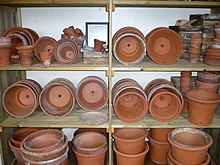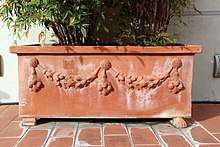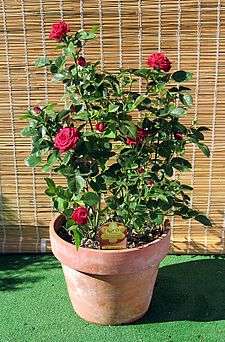Flowerpot
A flowerpot, flower pot, planter, planterette, or alternatively plant pot is a container in which flowers and other plants are cultivated and displayed. Historically, and still to a significant extent today, they are made from plain terracotta with no ceramic glaze, with a round shape, tapering inwards. Flowerpots are now often also made from plastic, metal, wood, stone, or sometimes biodegradable material. An example of biodegradable pots are ones made of heavy brown paper, cardboard, or peat moss in which young plants for transplanting are grown.


For seedling starting in commercial greenhouses or polytunnels, pots usually take the form of trays with cells, each cell acting as one small pot. These trays are often called flats.
There are usually holes in the bottom of pots, to allow excess water to flow out,[1] sometimes to a saucer that is placed under the flowerpot. The plant can use this water with its roots, as needed. Recently, some flowerpots have been made with an automatic watering system, using a reservoir.
Flowerpots
Flowerpots have a number of uses such as transporting plants to new locations, starting seeds, patio and indoor cultivation of plants, and the growing of tender plants in colder regions indoors.[2] Through the centuries, the use of flowerpots has influenced the horticultural use of plants, and the Egyptians were among the first to use pots to move plants from one location to another. The Romans brought potted plants inside during cold weather. In the 18th century, pots were used to ship breadfruit seedlings from Tahiti to the West Indies. Also Orchids, African violets and Pelargonium geraniums were shipped in pots from other parts of the world, including Africa, to North America and Europe.[3]
In the 18th century, Josiah Wedgwood's flowerpots or cachepots, were very popular; they were often highly decorative and used as table centrepieces.[4]
In Athens, earthenware flowerpots were thrown into the sea during the festival of the Gardens of Adonis. Theophrastus, c. 371 – c. 287 BC, mentions that a plant called southern-wood was raised and propagated in pots because it was difficult to grow.[5]
The top of the flowerpot underneath the rim is commonly known as the shoulder or collar and can aid handling.
Traditional classification
Flower pots were traditionally made from terracotta. They were made and sold by the cast, which is the number of pots produced from a given quantity of clay.
The traditional sizes[6] were as follows, although others existed:
| Name | No. to cast | Top diameter (inches) | Depth (inches) |
|---|---|---|---|
| Ones | 1 | 20 | 18 |
| Twos | 2 | 18 | 14 |
| Fours | 4 | 15 | 13 |
| Sixes | 6 | 13 | 12 |
| Eights | 8 | 12 | 11 |
| Twelves | 12 | 11.5 | 10 |
| Sixteens | 16 | 9.5 | 9 |
| Twenty-fours | 24 | 8.5 | 8 |
| Thirty-twos | 32 | 6 | 6 |
| Forty-eights | 48 | 4.5 | 5 |
| Sixties | 60 | 3 | 3.5 |
| Seventy-twos or thimbles | 72 | 2.5 | |
| Thumbs | 80 | 2.5 | 2.5 |
| Nineties or thumbs | 90 | 1 |
Other sources give different values, and sometimes names, for the smaller pots, for example The Gardener's Everyday Log Book while agreeing on "twos" to "thirty-twos" has two different types of "sixties" and disagrees on "thumbs" and "thimbles":[7]
| Name | Top diameter (inches) | Depth (inches) |
|---|---|---|
| Large sixties | 4 | 3.5 |
| Small sixties | 3 | 3 |
| Thumbs | 2.5 | 2.5 |
| Thimbles | 2 | 2 |
A taller and thinner shape of pot, suitable for deep-rooting plants, was known as a long tom, a term still used. The traditional size for a long tom used for auriculas was 3 in diameter by 3.75 to 4 in depth.[8]
Nursery pots
In the nursery business, plants are generally grown in round or square plastic pots.
United States
The sizes of plastic pots have been assigned an ANSI standard by the American Nursery and Landscape Association.[9] Pots designated #1–#100 nominally have the volume of that many gallons, but in fact a #1 pot has a capacity of 0.625 gallons (a "trade gallon").[10] There is also a Small Plant series: SP1, 6.5–8.0 in3; SP2, 13.0–15.0 in3; SP3, 20.0–30.0 in3; SP4, 51–63 in3; SP5, 93–136 in3. An SP4 pot is commonly called a "4-inch" or "quart" container.[11]
Europe
Plastic pots come in a number of standard sizes, with a code indicating the approximate dimensions of the diameter at the top.[12]
| Code | Diameter | Height | Volume | Approx. Imperial equivalent |
|---|---|---|---|---|
| 6F | 6 cm | 6 cm | 2.25" | |
| 8F | 8 cm | 7.5 cm | 3" | |
| 9F | 9 cm | 9 cm | 3.5" | |
| 10F | 10 cm | 9.5 cm | 0.5 l | 4" |
| 13F/14A | 13 cm | 12 cm | 0.9 l | 5.5" |
| 15F | 15 cm | 14 cm | 6" |
Gallery

 A flowerpot with straw, constructed to attract and house dermaptera species
A flowerpot with straw, constructed to attract and house dermaptera species Giant flowerpot[13]
Giant flowerpot[13] Flowerpots with the words "Trust" and "Love" on them
Flowerpots with the words "Trust" and "Love" on them Torenia flowers in a flowerpot
Torenia flowers in a flowerpot Creeping groundsel in a clay pot
Creeping groundsel in a clay pot Picture of an artificial potted plant with red flowers - Item from IKEA
Picture of an artificial potted plant with red flowers - Item from IKEA
References
| Look up flowerpot in Wiktionary, the free dictionary. |
- Handreck, Kevin A.; Black, Neil D. (2002). Growing Media for Ornamental Plants and Turf. UNSW Press. ISBN 9780868407968.
- "Etaerio - A Plant News Weblog: The History of the Flowerpot". Ubcbotanicalgarden.org. 2004-09-07. Archived from the original on 2010-05-24. Retrieved 2010-04-22.
- "In praise of the flowerpot / The Christian Science Monitor". CSMonitor.com. 2004-08-18. Retrieved 2010-04-22.
- Meteyard, Eliza (1866). The Life of Josiah Wedgwood: From His Private Correspondence and Family Papers. Hurst and Blackett. p. 154.
- Birch, Samuel (1858). History of Ancient Pottery. J. Murray. p. 202.
- Thomas, H. H.; Forsyth, Gordon. The Popular Encyclopedia of Gardening: Volume 1. The Waverley Book Company Limited. p. 320.
- A. J. Macself (1938). The Gardener's Everyday Log Book. Amateur Gardening. p. 329.
- Dorey, Paul (2011). Auriculas: an essential guide. The Crowood Press. p. 70.
- http://americanhort.org/documents/nursery_stock_standards_AmericanHort_2004.pdf, 2004
- http://www.landmarkplastic.com/ProductView/118/37/164
- Z60.1, p. ii-iii
- Erbertsankey catalogue 2014
- "Instructions and Tips for the correct planting". Retrieved 2017-03-01.
External links
| Wikimedia Commons has media related to Flowerpots. |
- The archaeology of the flowerpot in England and Wales c. 1650-1950 C.K. Currie; Garden History 21.2, 227-46 (1993)